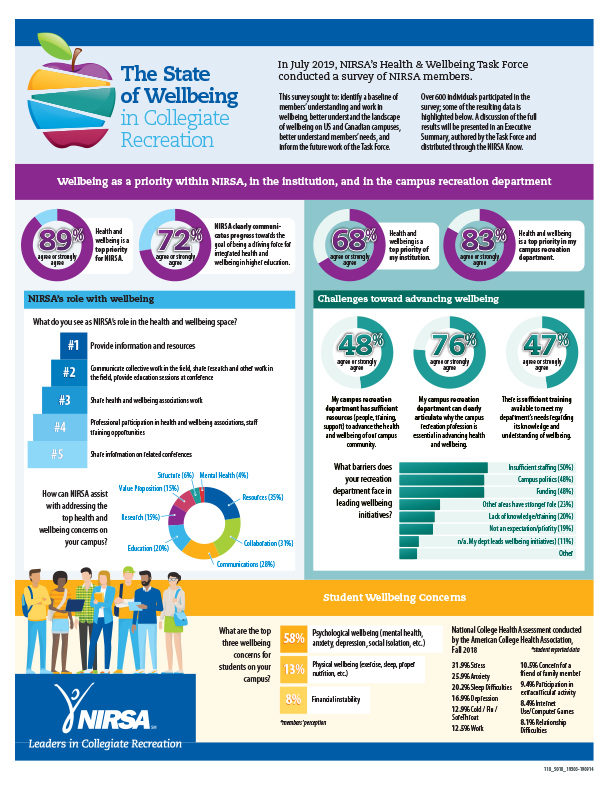2020 NIRSA Health & Wellbeing Survey Summary

Introduction
In 2018, NIRSA launched its current strategic plan to guide the Association forward to 2021, calling for an evolution in our professional engagement and our contributions to student success.
The landscape of higher education continues to change and so will the role of collegiate recreation. Research suggests that health-promoting institutions with an integrated, holistic wellbeing model—and a shared campus vision for execution—are successfully developing students who will be able to lead thriving and vibrant lives post-graduation.
Wellbeing is holistic and multifaceted. It is a goal and shared responsibility for the entire campus community. Collegiate recreation has long championed the tangible and intangible benefits of student participation in physical activity. Our profession is uniquely positioned to impact overall student wellbeing; collegiate recreation’s contributions can have broad sweeping influences on every aspect of wellbeing.
NIRSA leaders have named health and wellbeing as an integral value of the profession for nearly a decade. The NIRSA Health & Wellbeing Task Force was created in early 2019 to ensure that the Association makes demonstrable progress toward the strategic priority of being “a driving force in an integrated approach to wellbeing.” To date, the task force’s efforts have involved inter-association work with partners, colleagues, and allies in thought leadership and idea generation. It has also focused on the Association itself, with the intention of helping prepare colleagues to become proactive innovators and practitioners in the wellbeing space.
Background
The Health & Wellbeing Task Force’s appointment ensures that NIRSA’s strategic priority of “becoming a driving force in an integrated approach to health and wellbeing” is met. The NIRSA Board of Directors has given the task force significant latitude to articulate its goals and approach its work. Early on, the group determined that a survey of membership would provide critical information to set the stage for its next three years of work as well as define baseline measures to quantify future success.
In July 2019, the task force conducted a survey entitled “The State of Wellbeing in Collegiate Recreation,” which sought to investigate the following critical areas:
- members’ baseline understanding of health and wellbeing concepts and their specific work in supporting student wellbeing; and
- the landscape for and underlying challenges of integrating wellbeing on U.S. and Canadian campuses.
In addition, a third critical focus of the survey serves to inform the future work of the task force; the information gleaned will help the Association support members as they take on these new health and wellbeing challenges.
The 616 survey participants confirmed that health and wellbeing is a top priority for NIRSA and for most campus recreation departments. It is critical that the task force provides members with training, education, skills, and resources in order to help collegiate recreation take its place among campus leaders in the integrated wellbeing movement.
Survey Findings
Participants
The July 2019 survey was completed by an overwhelming majority of professional staff from four-year, public institutions serving in mid-level to executive-level management positions. Many came from institutions with a student body of 10,000 or more and there was a relatively even distribution among NIRSA regions. Most survey respondents report to the Division of Student Affairs versus Athletics. Sixty percent of survey participants hold at least one certification—NIRSA, NASPA, ACSM, and ACHA were the top member organizations.
Key Points
The results of the survey support the understanding that NIRSA has made health and wellbeing a priority within the Association; NIRSA is committed to driving the integration of health and wellbeing on campuses. Wellbeing is a priority for more than half of surveyed institutions as well as for most campus recreation departments. For some respondents, it’s more of a priority within their department than at an institutional level.
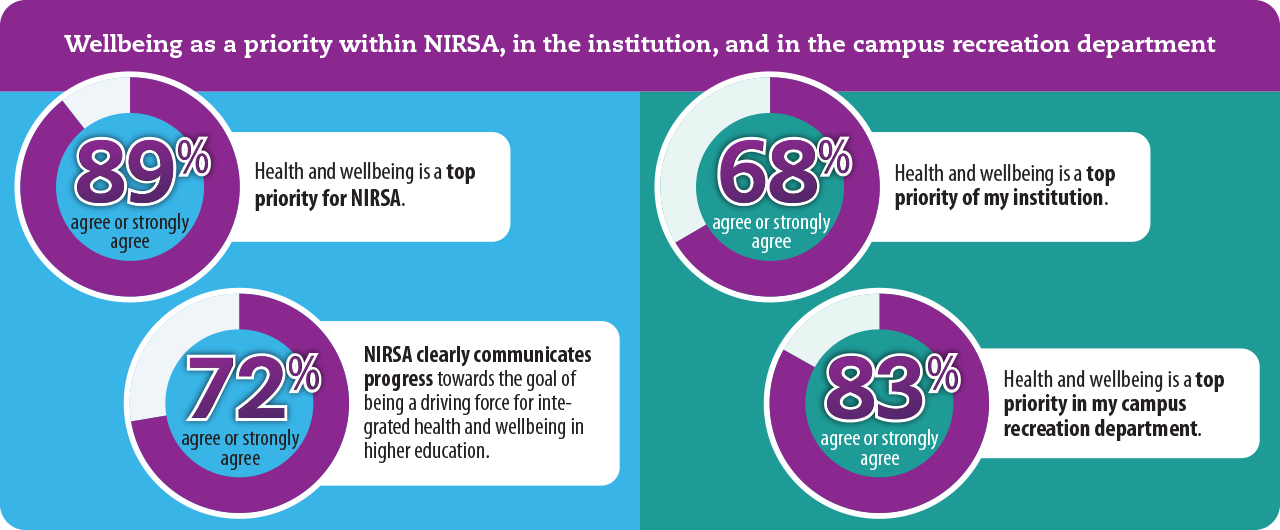
Survey respondents indicate that they can clearly articulate why collegiate recreation is essential in advancing health and wellbeing as well as how the health and wellbeing of the campus community impacts the role of their department and vice versa. On the departmental level there is a high level of understanding as well as prioritization of wellbeing; however, there is a gap between the departmental- and the institutional-level integration of wellbeing (i.e. mission statement). This demonstrates a potential opportunity for NIRSA’s work to help professionals close the gap, realigning institutional priorities and departmental work to address student health and wellbeing concerns.
Data-Informed Practices
Assessments provide institutions with opportunities to articulate their health and wellbeing concerns and to provide information about their activities, interests, and engagement opportunities.
The National College Health Assessment (NCHA) is a nationally recognized research survey facilitated by the American College Health Association (ACHA). It collects data about students’ health habits, behaviors, and perceptions. The survey offers campuses a way to map and benchmark a wide range of health issues. Sixty percent of survey respondents currently use the NCHA survey on their campus. Forty-three percent use other specific health-topic risk assessments (i.e. AAU, CORE, etc.). Only 15% use a wellbeing assessment (i.e. Wake Forest Wellbeing, Gallup Wellbeing).
In reviewing campus recreation professionals’ concerns regarding student wellbeing, the task force found that there was close alignment with students’ self-identified personal wellbeing concerns. Survey respondents indicated psychological wellbeing (mental health, anxiety, depression, social isolation, etc.) as the top student wellbeing concern. This was followed by physical wellbeing (exercise, sleep, proper nutrition, etc.) and financial instability. The top five student wellbeing concerns according to the Fall 2018 survey data revealed close comparisons.
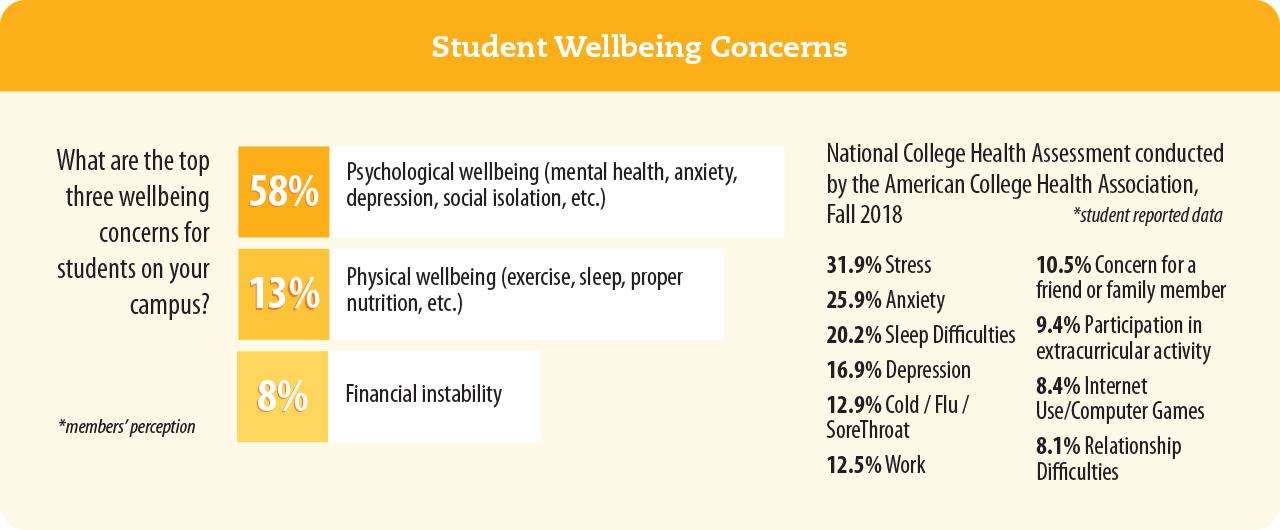
Spring 2019 NCHA data show an increase in areas related to mental health compared to in 2018; stress jumped to 34.2%, anxiety to 27.8%, sleep difficulties to 22.4%, and depression to 20.2%.
Mental health issues have become less stigmatized and students are more readily searching for assistance. There is a need for a more integrated approach toward prevention. While professionals appear to be aware of their student body’s wellbeing concerns, there are several challenges to advancing health and wellbeing on their campuses.
Challenges
Insufficient resources—including the lack of people, training, and support to advance the health and wellbeing of the campus community—are top challenges. Barriers identified in recreations’ ability to lead wellbeing initiatives include insufficient staffing (number of and/or level of expertise), campus politics, and funding. Fifty-three percent of respondents indicate that they do not have sufficient access to training that will broaden their department’s knowledge and understanding of wellbeing.
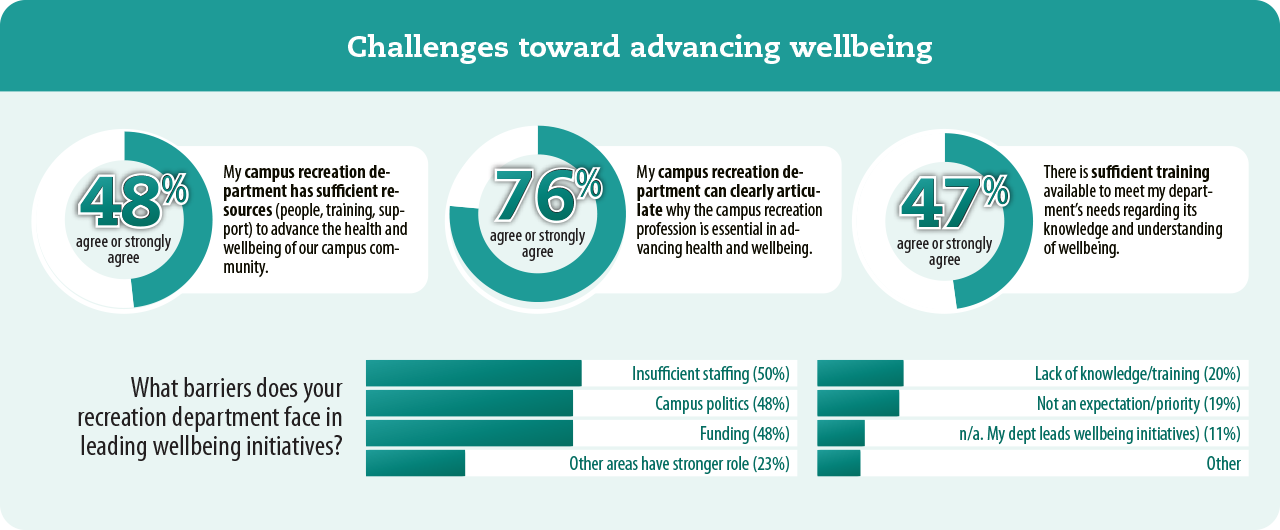
NIRSA’s Role and Resources
NIRSA is evaluating how it can best assist its membership within the health and wellbeing space. According to respondents, NIRSA’s number-one priority should be providing information and resources. Members are requesting communication on collective work in the field, the sharing of research and other work, and for NIRSA to provide timely and relevant educational sessions at conferences. Members would also like NIRSA to share other health and wellbeing associations’ work, increase our professional participation in these health and wellbeing associations, and expand training opportunities.
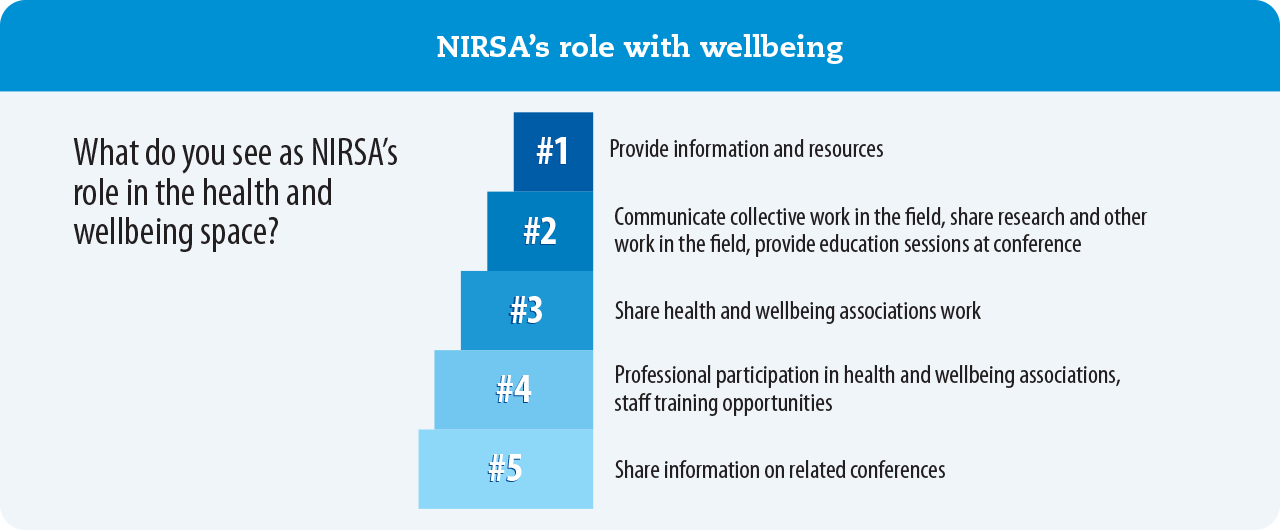
The qualitative responses provided were vast but supported NIRSA’s need to assist in addressing top health and wellbeing concerns through expanded resources, collaboration, communications, education, research, and the development of value propositions. There are opportunities for NIRSA to assist its membership in making meaningful connections in this space on campus.
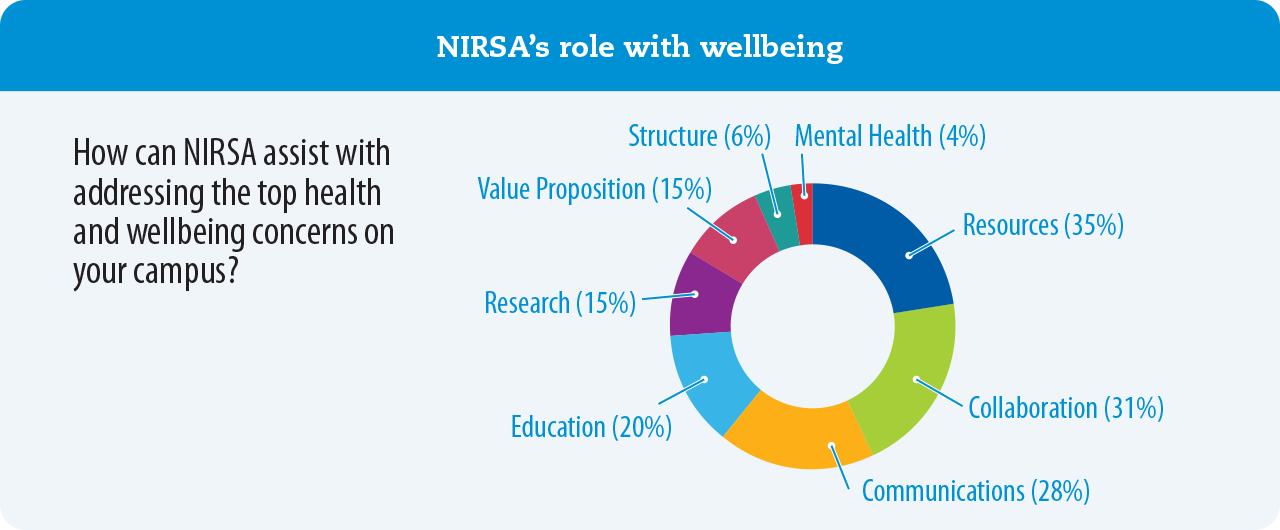
Conclusion
There is a growing movement to weave health and wellbeing into the fabric of our institutions. Campus recreation departments are an integral component of health and wellbeing initiatives. Some recreation departments are established drivers or strong collaborators while others are struggling to become part of this work at their institutions. Since NIRSA has established health and wellbeing as an integral value of the recreation profession—and is striving to become a driving force in integrative approaches—we must continue to work to establish the profession as a partner, colleague, and ally in this field. The task force’s top priorities include inter-association collaboration and support for members through education, resources, and skills.
Important revelations came to light through the initial investigation “The State of Collegiate Wellbeing in Collegiate Recreation.” There is a gap between departmental- and institutional-level integration of wellbeing (i.e. mission statement), creating a potential opportunity for professionals to help align institutional priorities and departmental work to address student health and wellbeing concerns. Seventy-six percent of survey respondents agree that the campus recreation department can clearly articulate why the profession is essential to advancing health and wellbeing, but only 30% strongly agree with this statement. Furthermore, 61% indicate that their department has been able to demonstrate its impact on student wellbeing. However, only 24% of professionals strongly agree that their level of education on wellbeing is sufficient for their role on campus. The Health & Wellbeing Task Force will use some of these findings as key performance indicators, expecting to see improvements through increased training and access to resources.
The Health & Wellbeing Task Force has identified common barriers in recreation departments’ taking a health and wellbeing leadership role on their campus: staffing, campus politics, and funding. The group will work to align resources with the challenges of its membership through shared research, educational opportunities, and the dissemination of other associations’ work in this space. In the years ahead, the task force will replicate the survey to assess the progress toward understanding individual and collective roles in the advancement of health and wellbeing, the integration of health and wellbeing on campuses, supporting membership needs, and articulating the impact recreation has on student wellbeing.


